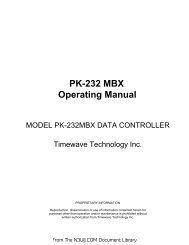DXE-RTR-1 Receive Antenna Interface for Transceivers - N3UJJ
DXE-RTR-1 Receive Antenna Interface for Transceivers - N3UJJ
DXE-RTR-1 Receive Antenna Interface for Transceivers - N3UJJ
- No tags were found...
Create successful ePaper yourself
Turn your PDF publications into a flip-book with our unique Google optimized e-Paper software.
Receiving <strong>Antenna</strong> Spacing GuidelinesThe overall benefits that receiving antenna offer is less noise. Weak signals can be heard on adedicated receive antenna because it rejects noise and strong stations by virtue of its design, size,directivity and lower sensitivity.There<strong>for</strong>e, placement of a receiving antenna is very important. Normally, excellent results areachieved by placing a receive antenna in a low noise environment. If possible, receive antennasshould be located at least 1/2-wavelength away from noise sources and noise re-radiating antennas.Houses, other metal or structures containing metal, metal fencing, towers and transmitting antennascan introduce noise into a receive antenna by proximity which may reduce the effectiveness of areceive antenna.However, in many cases, the physical space required <strong>for</strong> the ideal receive antenna installation is notavailable to the average back yard. The following diagrams (1-7) of typical and special systemconfigurations show absolute minimum spacing between transmitting and DX Engineering Active<strong>Receive</strong> <strong>Antenna</strong>s. For optimal per<strong>for</strong>mance, greater spacing is recommended <strong>for</strong> better receptionresults.Diagram 8 shows phasing of a mono-band or multi-band vertical antenna using a <strong>DXE</strong>-ARAV2-1PActive <strong>Receive</strong> Vertical <strong>Antenna</strong> with the <strong>DXE</strong>-NCC-1 <strong>Receive</strong> <strong>Antenna</strong> Phasing Controller. Thespacing described is 1/4 to 1/2-wavelength between the transmit antenna and the Active <strong>Receive</strong><strong>Antenna</strong>. This distance is based on optimal per<strong>for</strong>mance of the equipment described.For in-depth receiving antenna system in<strong>for</strong>mation, please consult the ARRL <strong>Antenna</strong> Book orON4UN's Low Band DXing book.Typical System ConfigurationsIn most cases, the operator will purchase the <strong>DXE</strong>-<strong>RTR</strong>-1 because they want to use a receiveantenna on a transceiver which lacks a receive antenna input. See the text below and use Diagram1B <strong>for</strong> an example using the <strong>DXE</strong>-<strong>RTR</strong>-1 with a transceiver having a <strong>Receive</strong> Input and Output.All transceivers under 200 watts output may be connected to the <strong>DXE</strong>-<strong>RTR</strong>-1 as is shown inDiagram 1A, and all other Diagrams 2 through 9, even if it has a receive antenna input.Diagram 1A illustrates the positions and connections to a standard transceiver <strong>for</strong> optional receiveenhancement products from DX Engineering. A simple Beverage antenna or receiving loop antennamay be connected directly to the RX ANT connector on the <strong>DXE</strong>-<strong>RTR</strong>-1. If a single <strong>DXE</strong>-ARAV2-1P Active <strong>Receive</strong> Vertical is purchased, then the included powering device, model <strong>DXE</strong>-FVI-1, is placed in-line in the shack between the Active <strong>Receive</strong> Vertical and the RX ANT input, orbetween the optional <strong>DXE</strong>-RPA-1 <strong>Receive</strong> Preamplifier and the <strong>DXE</strong>-RFCC-1 <strong>Receive</strong> FeedlineCurrent Choke.Diagram 1B illustrates how to connect the <strong>DXE</strong>-<strong>RTR</strong>-1 to a transceiver using available receiveinput and output connectors. For in<strong>for</strong>mational example purposes, here is a partial listing of thetransceivers that can benefit from connections with the <strong>DXE</strong>-<strong>RTR</strong>-1: Yaesu FT-1000 series, FT-1000MP/ MKV series, FT-2000 series and FT-9000 series; Icom IC-7800, IC-7700, IC-7600, IC-765, IC-761 and IC-781.Most high-end transceivers, old and new, offer a receive antenna input that DOES NOT interrupt or11From The <strong>N3UJJ</strong>.COM Document Library
















